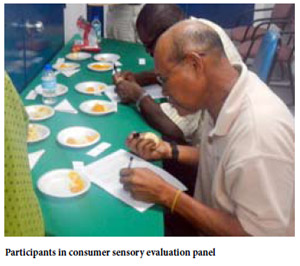 |
 |
 |
|
January 2013 |
The project was conceptualised with a farm to fork approach with agricultural diversification, conservation of water and the efficient use of land increasing farmer productivity and supplying the population, particularly vulnerable groups such as women and children. The research activities in this project revolve around three fundamental themes: Community nutrition and health; socioeconomic and market access, and water and land resources. The latter comprises a number of subthemes: protected agriculture and open field diversification, irrigation and water and soil conservation; small ruminant production; food safety and quality and postharvest technology. The project targets primary school children, women and small holder farmers as the agents of change, given the dominant role these groups have in influencing household eating behaviour. This approach increases the likelihood of success in achieving food and nutrition security in the project countries. Under the subtheme “protected agriculture and open field diversification,” the research team has evaluated various pumpkin varieties at the University Field Station and in collaboration with farmers from the Cunupia Farmer’s Association. Pumpkin (Cucurbita maxima) is an important traditional vegetable crop in Trinidad and Tobago and other Caribbean countries. It is a commodity loaded with vitamins A and E, minerals (iron, potassium, calcium and phosphorus), anti-oxidants such as leutin, xanthin, and carotenes, dietary fibre and low calories. These antioxidants decrease the risk of cardiovascular disease and lung cancer and help protect against age related eye disease. It is an important part of the local diet where it is mainly produced by small farmers. In 2004, Trinidad exported over 2200 tonnes of pumpkin which translates into substantial foreign exchange earnings. Production has since been declining. There is a gap between actual and potential yields and hence there are opportunities for enhanced productivity through the adoption of improved varieties in the local production systems. Varieties suitable for the local market are determined by, taste and thickness of skin, whereas those suitable for the export market are the smooth skin and weight (about 25 kg). Many farmers grow pumpkins because it takes a relatively short time to produce fruits, between 3-3.5 months. Yields are between 8,000-10,000 pounds per acre. Most farmers plant one crop in June/July and the other crop in October/November. Farmers who have access to irrigation systems can often produce the crop year round. If pumpkins are harvested, handled and stored correctly, they can remain marketable for up to two months. The varieties under evaluation include Crapaud Back (popular local variety), Bodles Globe (new Jamaican variety) and Future NP-999 (Chinese variety). The project hosted a Pumpkin farmer forum in December, 2012 at the Frank Stockdale Building, St. Augustine Campus. The forum was opened by Dean, Faculty of Food and Agriculture, Prof Carlisle Pemberton and presenters included Dr Isabella Granderson, Dr Wendy-Ann Isaac, Dr Majeed Mohammed and Prof Neela Badrie. This forum allowed discussion on the major concerns facing the industry and share best practices in production. Farmers were also introduced to new trial varieties that would improve production. Representatives from the Agricultural Society of Trinidad and Tobago (ASTT), Cunupia Farmers Association, the National Agricultural Marketing and Development Company (NAMDEVCO), Trinidad and Tobago Agribusiness Association (TTABA), the National School Feeding Programme (NSDLS) and Ms Albada Beekham, Research Officer from the Ministry of Food Production as well as UWI technicians and lecturers attended. They participated in a consumer preference evaluation of five pumpkin varieties, including three of the varieties being evaluated, Chinese squash (a new variety gaining popularity in local markets) and CES STARZ (a new variety developed by the Ministry of Food Production for the export market). They evaluated the overall acceptability based on colour, texture, taste, sweetness and cooking quality and rated their preference for export and local markets. They also sampled several pumpkin products including, bread, muffins, cookies, patties, drinks, ice cream and soup. The Forum will be one of many planned outreach workshops to educate farmers about best practices to improve production both in scope and variety while conserving land and water.
For further information on the project, please contact Ms. Takiyah Defour, Project Manager, 662-2002 ext. 83200.Dr Wendy-Ann Isaac is at the Department of Food Production, Faculty of Food and Agriculture, UWI, St. Augustine. |


 The UWI, St Augustine, in collaboration with Mc Gill University, Canada has embarked on an ambitious project which aims at improving the nutrition and health of CARICOM populations with a systems approach to food availability, safety and quality. The four-year project: “Improving the nutrition and health of Caricom populations by increased food availability and diversity through sustainable agricultural technologies,” began in March 2011 and targets four Caricom territories: Trinidad, St. Kitts, St. Lucia and Guyana. The project is funded by the International Development Research Center (IDRC) and the Canadian International Development Agency through the Canadian Food Security Research Fund.
The UWI, St Augustine, in collaboration with Mc Gill University, Canada has embarked on an ambitious project which aims at improving the nutrition and health of CARICOM populations with a systems approach to food availability, safety and quality. The four-year project: “Improving the nutrition and health of Caricom populations by increased food availability and diversity through sustainable agricultural technologies,” began in March 2011 and targets four Caricom territories: Trinidad, St. Kitts, St. Lucia and Guyana. The project is funded by the International Development Research Center (IDRC) and the Canadian International Development Agency through the Canadian Food Security Research Fund. 